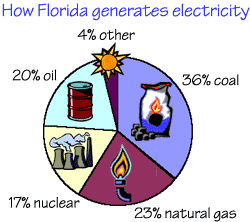
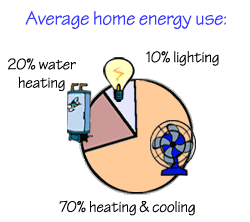
"Note – this is an old website and the new management for Harmony (Starwood Capital) is no longer supporting the maintenance of sustainability information for the community."

As America's need for energy grows, so does the need for energy efficiency. In 2000, Florida ranked 4th in the US in total energy consumption totaling 988.6 trillion British Thermal Units (BTU). (A British Thermal Unit is the amount of energy required to raise the temperature of one pound of water by 1°F.) If you adopt energy efficient behaviors and technologies, you can reduce your energy consumption and save money.


Homes built in Harmony are designed and built to meet strict energy efficient standards. Since the first home was built at Harmony, houses have been meeting at least one of several rating programs that assure each can use less energy than those built simply to meet Florida Building Code requirements. These certifications are achieved through a combination of energy efficient heating, cooling, hot water use, energy efficient appliances, and lighting. The benefits (PDF) of a home built to higher energy standards are improved home quality and homeowner comfort, lower environmental demand, reduction in air pollution, and lower utility costs.
A key component in a sustainable community such as Harmony is energy-efficiency. Since the beginning Harmony has promoted energy efficient living through programs incorporating products and practices that improve home quality and comfort while reducing energy and environmental demand.
Current programs are:
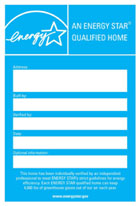
EnergyStar®, a joint program of the U.S. Environmental Protection Agency and the U.S. Department of Energy is the pinnacle rating for energy saving products. Since 1995 the program and label has been extended to cover both commercial and residential construction and provides technical support to approximately 20,000 public and private organizations. In order to qualify a home must be efficient in categories pertaining to insulation, heating and cooling, air distribution, lighting, and appliances. Strict guidelines are set and must be verified by an independent Residential Energy Services Network (RESNET) rater. When met a qualifying home is 20-30% more efficient than the standard homes. All certified homes receive a blue label that is usually found on the circuit breaker box.
The U.S. Department of Energy's Builders Challenge® program works with the private sector, local and state governments, and universities to improve buildings and building system efficiencies. The focus of this program is to use advanced technologies in construction, lighting, heating and cooling to improve energy efficiency in new and existing homes. This program is primarily a resource for residential and commercial builders providing requirements guidelines and recommendations concerning construction material, ventilation, interior coatings and appliances. As with EnergyStar® verification is done by an independent Residential Energy Services Network (RESNET) rater. Certification labels are then placed on the electrical circuit breaker box.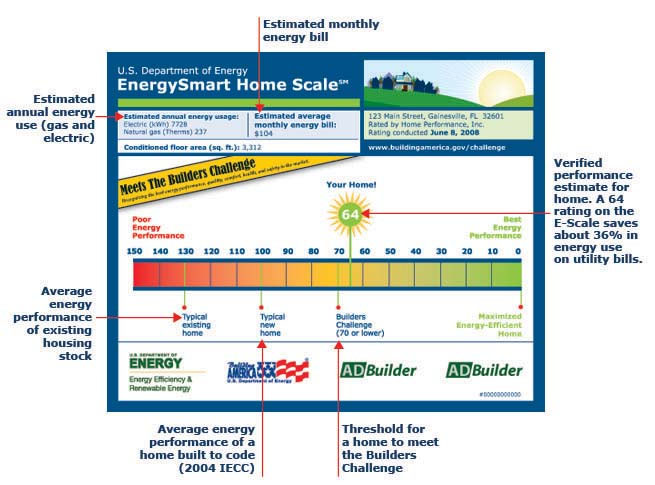
Environments for Living® program is an initiative of Masco Home Services, Inc., a Masco company, providing building science and energy efficiency services. The Environments for Living's Wellhome initiative offers an all-in-one service to improve energy efficiency and comfort for existing home owners. Using Building Science, a discipline that looks at a house as an integrated system of components working in harmony to provide energy efficiency, homeowners can work with builders to choose which level of participation best suits their needs. Household components that make up the program are energy efficiency, durability, indoor environmental quality, and water efficiency. The Environments for Living program also guarantees that your new home will provide heating and cooling reductions.

None of these programs endorses specific brand names but products such as compact fluorescent or LED lighting, low emissivity windows, and durable low volatile organic compound (VOC) paint and carpet are required. Low-flow bathroom and kitchen fixtures along with high efficiency toilets and appliances are also necessary for certification.
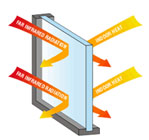 |
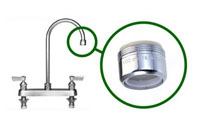 |
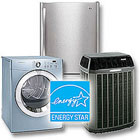 |
Improve your home's energy efficiency |
|||

|
Money-saving
tips Here are some quick ways to help decrease the amount of energy you use and lower your energy bill. |

|
Lighting Increasing your lighting efficiency is one of the fastest ways to decrease your energy bill. |
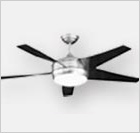
|
Heating
and Cooling There are many ways to reduce the amount of conditioned air that is lost and decrease the amount of energy spent to heat and cool your home. |
 |
Water
Heating Save energy and cut down on the amount of money spent on water heating. |

|
Insulation Insulation acts as a barrier to keep home temperatures more constant while reducing your energy costs. |

|
Landscaping
for energy Landscaping is a good way to keep energy costs down in the home. |